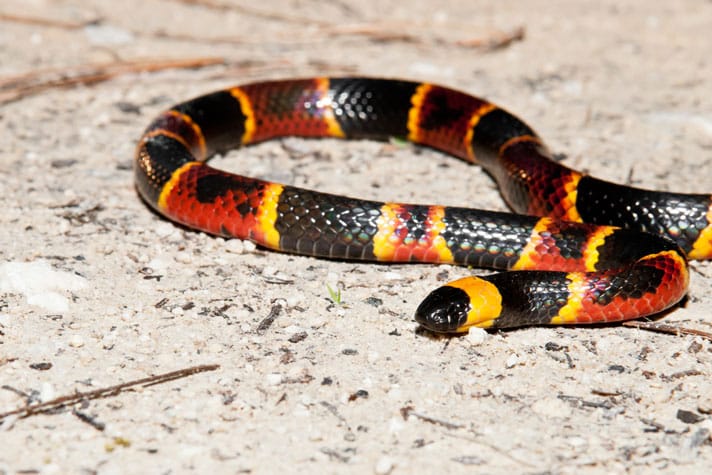Some of these North American venomous snakes pack a lot of venom.
It really doesn’t take much to make this list, if you’re a venomous North American snake. There are 21 species listed by the Society for the Study of Amphibians and Reptiles. Nearly two thirds of the venomous snakes are true rattlesnakes (Crotalus) along with one, Sistrurus miliarius carrying the common name, pygmy rattlesnake, to bring the total to 14.
Venomous Snake Information
Rattlesnakes Packing More Venom In California
Snake Fungal Disease Found in Michigan Rattlesnakes
The Cruelty Of Rattlesnake Roundups
Of course, venomous doesn’t always mean lethal. The aforementioned pygmy rattlesnake rarely grows beyond 24 inches and has limited amounts of venom. It can cause severe reactions, but is probably not life-threatening to most adults.
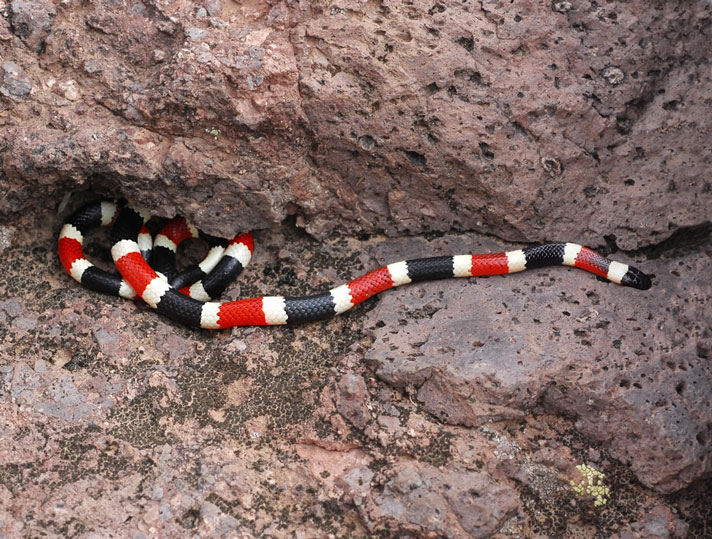
jokerbethyname/Shutterstock
Western coral snake.
Likewise, lethal and highly toxic do not equate (always) to the level of threat to humans. The yellowbelly sea snake has among the most deadly bites of any snake in North America, but because it rarely leaves the water, there have been no reported human deaths from its bite.
The good news is that snake bites are pretty rare in the United States with estimates between 1,000 to 2,000 cases each year and fatalities from those bites averaging less than a handful. Globally, it is estimated that there are millions of bites annually with well over 100,000 snake bite-related deaths. Excellent pit viper anti-venom (effective for rattlesnake, cottonmouth, and copperheads) are readily available in most areas of the U.S.
Because they are so similar, the Eastern and Western Coral snakes are discussed together. It is interesting to note that within the last decade there has been debate on adding the Texas coral snake as a third variant. Consider all three as dangerous, but only count the three as two members of our top 10.
Eastern Diamondback Rattlesnake
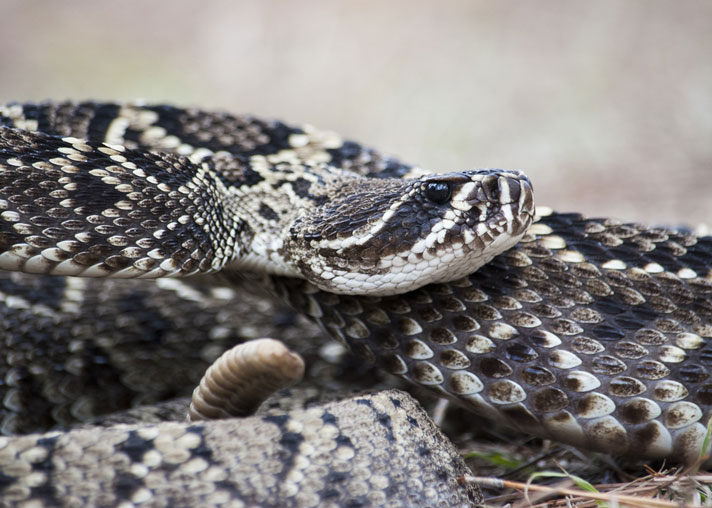
Brittany Mason/Shutterstock
Crotalus adamanteus, the Eastern diamondback, is the biggest venomous snake in the Americas.
Crotalus adamanteus, the Eastern diamondback, is the biggest venomous snake in the Americas, and may be the biggest in the world. With recorded lengths nearing eight feet and weights in excess of 35 pounds, this is a significant creature and is quite dangerous to humans with a fatality rate of 10-20% (although rates were claimed as high as 30% at one time).
This massive predator primarily feasts on rabbits. As with most rattlesnakes, its venom is highly hemorrhagic and contains some peptides that can cause cardiac problems, leading to death. As befitting its stature, the Eastern diamondback is equipped with massive fangs that can approach a full inch long and can pump as much as 450 mg of venom (less than 150 mg can kill a human). Massive doses of CroFab anti-venin are effective in treating people.
Pine forest, mountain, dry marsh, and coastal areas of Florida and the lower southeastern U.S. are its prime habitat. Aside from its size, the sharp and well-defined black diamond patterns offset by yellow borders can help identify this snake. A highly developed rattle can be heard easily from many yards away, but as with all rattlesnakes, it is quite capable of striking without using the warning system. Strike distance can be nearly a third of the snake’s length.
Western Diamondback Rattlesnake
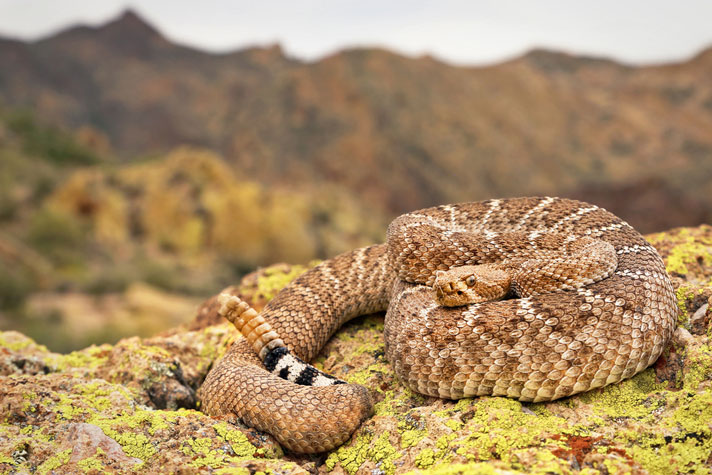
Ryan M. Bolton/Shutterstock
The Western diamondback only trails its Eastern cousin (slightly) in U.S. annual fatalities and would probably be the leading killer if its habitat were less sparsely settled by humans.
Crotalus atrox may not be quite as massive as its Eastern relative, but it makes up for that in numerous ways. The brownish “base” with cream outlines around the classic diamond shape and a quick to respond rattle announce its presence. The Western diamondback has a massive range, extending well into Mexico and stretching from the Southeast to California and approximately halfway to Canada.
Although the venom is somewhat less toxic than some other rattlesnakes, it makes up for it by producing immense quantities, as much as 800 mg can be delivered in a full envenomation (which, thankfully are rare). The venom causes severe muscle deterioration as well as massive internal bleeding. As with the Eastern diamondback, fatality rates are estimated at 20 percent. The Western diamondback only trails its Eastern cousin (slightly) in U.S. annual fatalities and would certainly be the leading killer if its habitat were less sparsely settled by humans. The Western diamondback is easily the snake most responsible for venomous snakebite deaths in Mexico.
Regarded as the most aggressive of the rattlers, it can grow up to seven feet and 15 lbs., but typical specimens are in the 4-5 foot range and less than 10 pounds. Preferred habitat is actually quite diverse, but sandy, sun-warmed desert, salt marshes, and rocky mountain areas are prime locations.
Coral Snake (Eastern and Western)
The Western (Micruroides euryxanthus) and Eastern (Micrurus fulvius) coral snakes are pretty similar in many ways. Both have some of the most potent neurotoxic venom in North America, both are brightly colored with primary black and red stripes with smaller yellow encircling stripes, and both species prefer the southern part of North America. Fortunately, both snakes are reluctant to bite humans and tend to be primarily nocturnal, further lessening the chances of fatal encounters.
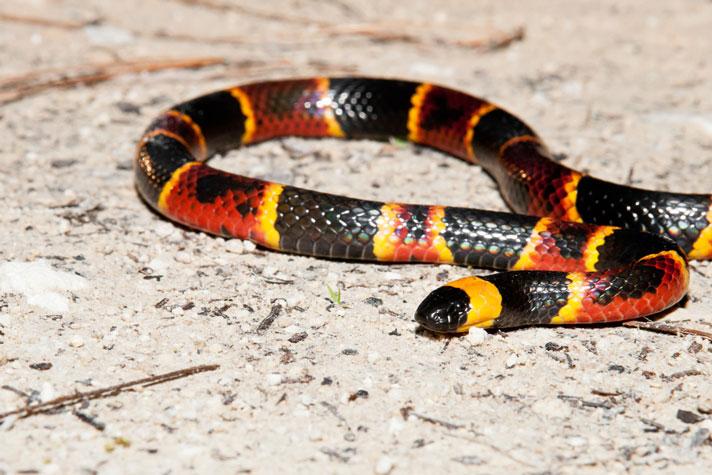
JAY ONDREICKA/SHUTTERSTOCK
The Western (Micruroides euryxanthus) and Eastern (Micrurus fulvius, above) coral snakes are pretty similar in many ways.
Each is an egg-laying species, with the female typically growing slightly larger than the male. The Eastern coral snake is slightly larger, with captive specimens reaching nearly 40 inches while typical wild specimens are between 24 to 30 inches long. The Western coral snake is approximately 24 inches with larger examples exceeding 30 inches.
There currently is no effective anti-venin. Wyeth discontinued production in 2010 due to economic factors. Without the antivenin, fatality rates are estimated to be as high as 20 percent, but there are a number of factors that have led to only a single death in more than 40 years. Coral snakes are unable to release their venom fully in a single strike and full evenomation requires a chewing-like process and a relatively long bite. It is estimated that 40 percent of the bites (about 100/year in North America) to humans contain no, or very little venom.
If you are bitten, hospitalization is highly recommended because symptoms can be delayed as much as a day, but progression can be extremely rapid. A typical coral snake (either variety) carries approximately enough venom to kill four full-grown adults and the amount required to severely injure or kill a person is only 4 to 5 mg.
Although rarely seen in daylight, the Western coral snake prefers dry, rocky areas and desert. The Eastern coral snake typically burrows underground during the day and prefers leafy forest areas. Neither variety is known to hunt mammals, preferring small lizards, insects, and other snakes. Recently, a third variant of the North American coral snake has been recognized, the Texas (Micrurus tener) coral snake, which shares most of the traits of its Eastern and Western siblings. The Texas Coral Snake is found primarily in dry, rocky ravines in Texas, Arkansas, and Louisiana. Like all North American coral snake varieties, it is banded in black and red with the smaller yellow bands.
Copperhead Snake
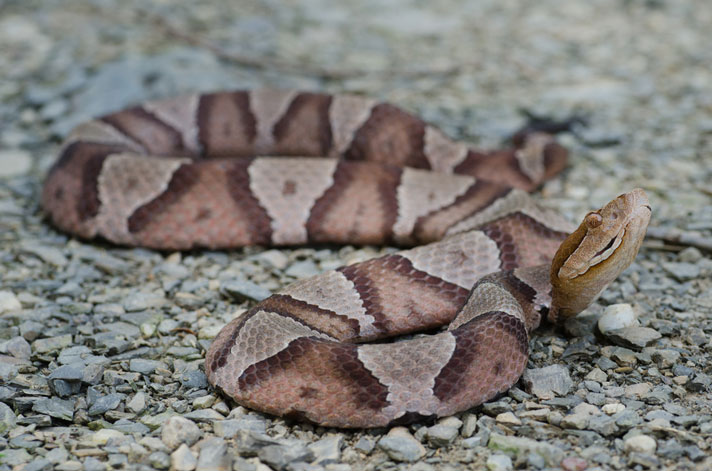
Jason Mintze/Shutterstock
The copperhead (Agkistrodon contortrix) is a member of the pit viper family, like most of the venomous snakes in North America.
The copperhead (Agkistrodon contortrix) is a member of the pit viper family, like most of the venomous snakes in North America. Its primary range is along the Eastern Seaboard as far north as New York and inland as far west as Nebraska.
A moderately-sized snake, most copperheads are less than 36 inches with larger specimens reaching 48 inches. The snake is fairly stout with weights from 1/2 to 3/4 of a pound. The copperhead’s venom is relatively mild and while painful, is very rarely fatal. There is an antivenin that is sometimes used, but mostly, because the potential side-effects are worse than the affliction, treatment is basic and mostly topical.
Considered non-aggressive, when excited/threatened, the copperhead will often assume a “freeze” strategy and rely on its excellent camouflage (ironically, making it easier for unwary humans to step on it, provoking a bite). All pit vipers are capable of delivering a bite with little or no venom delivered, but the copperhead is unique in that most defensive first strikes include no venom. If the snake is still being threatened, a second strike almost always does include venom.
Two of the non-rattlesnakes are closely related, the copperhead and the cottonmouth. Although a bite from either can be nasty, neither is considered particularly deadly.
Cottonmouth Snake
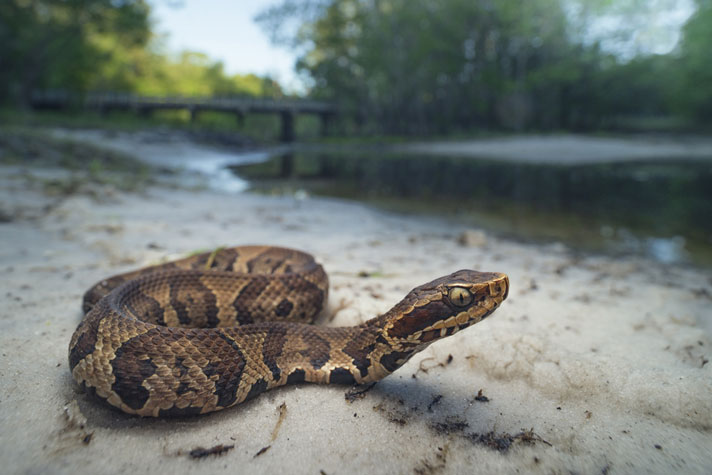
Kristian Bel/Shutterstock
Cottonmouth snakes are semi-aquatic.
The cottonmouth (also known as the water moccasin) bite is much more dangerous and harmful to humans than the bite of the closely related copperhead, but rarely leads to death. The cottonmouth is more aggressive, but as with the copperhead, biting isn’t common unless the snake is actually touched.
Conversely, the cottonmouth/water moccasin has a more aggressive reputation, but when threatened, will occasionally hiss and almost always assume a strike-ready pose. The very white interior of the cottonmouth’s mouth and the snake’s habit of opening its mouth extremely wide in warning provides the common name.
The cottonmouth is somewhat larger than its cousin, the copperhead, reaching reported lengths of 72 inches with averages exceeding 36 inches. In addition to being larger, the cottonmouth has a slightly more powerful venom, but is still rarely lethal to humans.
The biggest difference between the cottonmouth and the copperhead is that cottonmouth snakes are semi-aquatic and are most commonly found in marsh, swamp, and warmer streams and lakes. The cottonmouth is the only semi-aquatic viper in the world. They have been seen in saltwater and have colonized some near offshore islands on the east coast.
Yellow-bellied Sea Snake
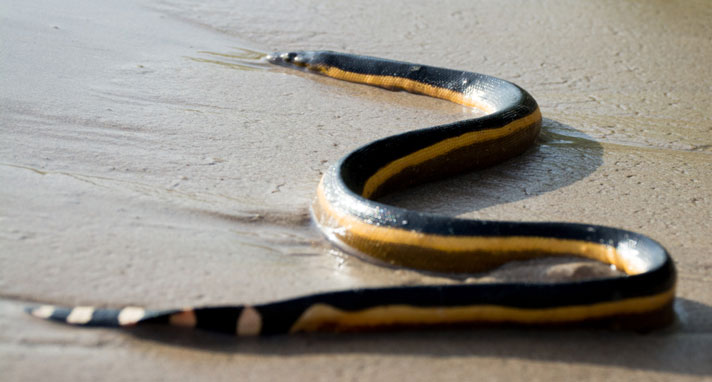
Maciej Bogusz/Shutterstock
The yellow-bellied rarely comes ashore, where it is poorly adapted.
A bit odd for this list, the yellow-bellied sea snake (Pelamis platura) is not exclusive to oceans off North America, and there have been no known fatalities in the U.S. from its bite. However, its venom is highly potent with potential human-lethal doses as small as .067 mg and the average bite delivering as much as 4.0 mg.
Preferring warm ocean waters, the yellow-bellied sea snake frequents the Pacific from the state of Washington down into South America and inhabits virtually all warmer waters through the Pacific and Indian oceans. The yellow-bellied rarely comes ashore, where it is poorly adapted, giving live birth in calmer seas and occasionally in tidal pools. It will not venture into fresh water and feeds almost exclusively on fish.
Females can reach lengths of nearly three feet, while males generally will not exceed 28 inches. Even with a massive range that includes virtually all the oceans, excepting the Atlantic and the Meditranean, it is surprising that there are no sub-groupings or sub-species of the snake. There are however, some variants in coloration. The classic and predominant coloring is a sharply divided yellow or pale brown underside with a black or dark brown upper body. Some are almost entirely yellow and others may have black mottling or thin black striping along the belly.
Descended most likely from Australian land-based snakes, the most effective anti-venoms are produced in Australia, and the most widely distributed is the tiger snake (40-60% estimated fatality) anti-venom. Because envenomation is exceedingly rare with the yellowbelly, no fatality estimate has been made.
Timber Rattlesnake
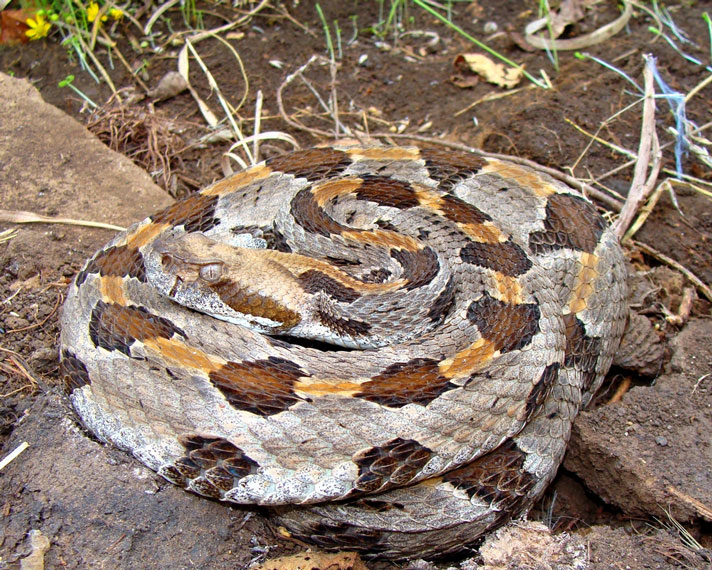
Matt Jeppson/Shutterstock
The third most dangerous rattlesnake in North America, the timber rattlesnake (Crotalus horridus) lives in the densely populated northeastern area of the United States.
Actually the third most dangerous rattlesnake in North America, the timber rattlesnake (Crotalus horridus) lives in the densely populated northeastern area of the United States. The snake, gracing the famous Gadsden flag (don’t tread on me), certainly has spawned more fear and respect from settlers than any other through the history of the United States.
One of the larger rattlesnakes, the timber rattler can grow to more than five feet with the largest recorded at a few inches beyond 6 feet. Large specimens can weigh nearly 10 lbs. Typical adults will be near 40 inches. As with all rattlesnakes, the timber rattler can deliver considerable venom in a single, quick bite. Also typical of the entire genus, toxicity can vary among specimens, for the timber rattlesnake, this is especially pronounced and varies by region. In the more extreme northeast, the venom is primarily hemorrhagic, while venom from the more southern specimens contains significant neurotoxin. Snakes in the middle may have elements of both, making their bites extremely toxic. A third population, mixed throughout the range have relatively mild toxicity. However, with their large size, extremely long fangs, and the ability to deliver massive doses, a timber rattlesnake bite should be considered life-threatening.
Fortunately, the timber rattlesnake is generally hesitant to strike defensively, displaying a long and vigorous posture with a loud rattle. Once common throughout the northeast and into Canada, the timber rattler is the most northern of the large rattlers but has been listed as extinct in Ottawa (although being considered for reintroduction as a pest rodent control). It is also considered extinct in Maine, Rhode Island and nearly so in New Hampshire.
An ambush hunter that preys primarily on rabbit, birds, and small rodents, the mottled brown (often nearly black) snake prefers to blend in with leafy material and can be extremely difficult to see. Females tend to seek sunny open areas when preparing to give birth to 10-20 (typical) young.
Mojave Rattlesnake
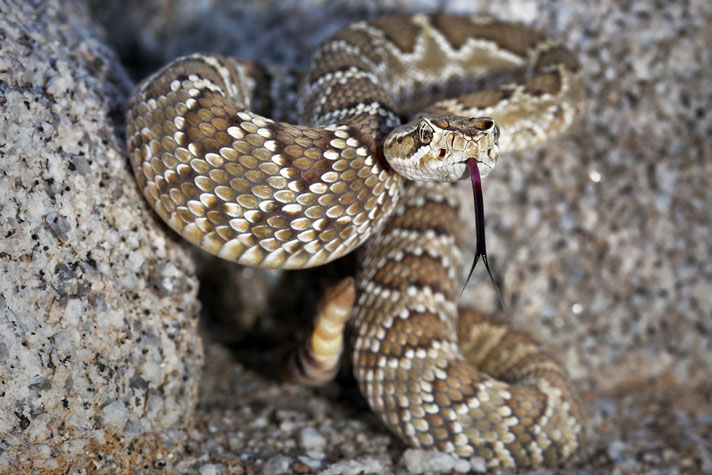
Ryan M. Bolton/Shutterstock
The Mojave rattler has the most toxic venom and a reputation as extremely aggressive toward humans.
Certainly not the biggest, nor the most widely ranging or populous of the rattlesnakes, the Mojave rattler (Crotalus scutulatus) has the most toxic venom and a reputation as extremely aggressive toward humans. Physically similar to the Western diamondback, the Mojave rattler typically shades toward green, sparking the common name, Mojave greens.
Limited to the southern areas of Arizona, California, Utah, New Mexico, and parts of Texas, the Mojave rattlesnake prefers open areas of sparse vegetation and sandy, desert conditions. It will use a sidewinding locomotion when appropriate, but most typically does not.
The snake can reach nearly four feet long, but averages less than 36 inches and are relatively stout. They feed on lizards, other snakes and most often on small mammals and rabbits. As common among pit vipers, they will often strike prey, then disengage and track the prey as the venom kills it.
Comprised of a combination neurotoxin along with the more common hemophagic elements, the Mojave rattlesnake venom is considered more toxic than even Australia’s famed tiger snake. Because bites often bleed less and cause less initial distress, it isn’t uncommon for people that have been bitten to underestimate the peril. The combination neurotoxins can cause massive negative effects that only become obvious as long as 24 hours after envenomation. The most common anti-venom in the U.S. is based in large part on the venom of the Mojave rattlesnake and is highly effective when administered promptly.
Massasauga Rattlesnake
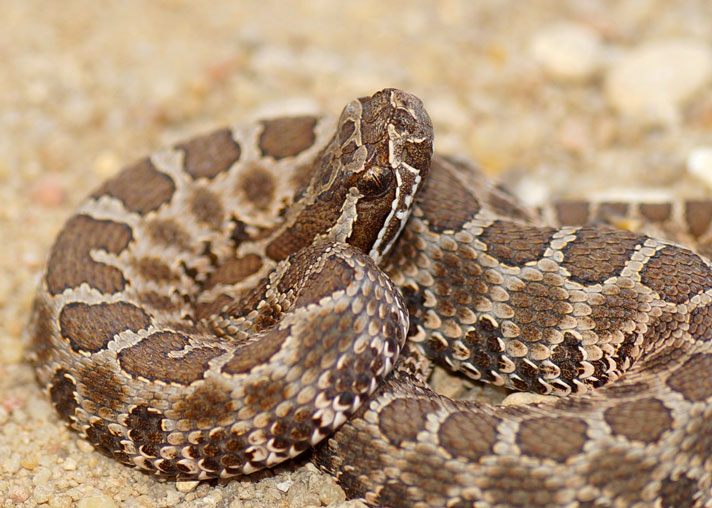
Matt Jepson/Shutterstock
The venom of the Massasauga is moderately toxic, but the specific anti-venin is rare.
Also known as the black rattlesnake, (Sistrurus catenatus) is a northern ranging rattlesnake most common in Ontario and Michigan and through the upper Missouri valley with populations reported in Colorado and ranging down to Mexico.
A smaller species of rattlesnake, the Massasauga rarely exceeds 24 inches with large specimens topping out at 30 inches. They feed on small mammals, lizards and small snakes, some insects, and will feed on frogs more than most rattlesnakes.
The venom of the Massasauga is moderately toxic, but the specific anti-venin is rare. Treatment is generally with “generic” rattlesnake anti-venins and no fatalities have been reported among those getting treatment, although there are multiple instances of untreated bites resulting in human death over the past few decades.
The snake prefers marsh and grasslands and is rarely seen on mountainous terrain (above 1,500 feet). It is considered relatively non-aggressive toward humans, but as with all pit viper species, will strike if threatened.
What to Do if Bitten by a Rattlesnake or Coral Snake
Do NOT try and capture the snake or have a friend attempt it—this almost always results in another bite or another victim. The hospital and doctors do not need the snake, nor do they want it. You do want to try and get as good a description of it if possible, but really you mostly want to be able to tell medical personnel if it was a rattlesnake or a coral snake.
Get to a doctor or hospital as quickly as possible, even if you are having little or no distress. Many venom effects can be delayed, but waiting until the symptoms hit can make treatment less effective. Do not incise and suck the blood/venom out or allow anyone else to do so. This is not only inneffective and pointless, it is dangerous to both the victim and the person attempting this non-treatment.
Go ahead and elevate the bitten area if it helps, but basically, what you want to do is get to a medical facility. There are virtually no first-aid remedies that are effective. Whiskey is good, but it won’t help a bit and being intoxicated can both get in the way of your treatment and make it difficult for you to relay important information to the care provider.
Stay calm. Treatment for snake bites is very effective and few people die if they seek treatment immediately. You probably won’t significantly affect the course of the venom by freaking out, but losing your composure may put you at greater risk of injury.

